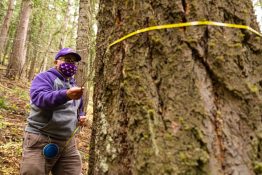Nature is full of repeating patterns that are part of the beauty of our world. An international team, including a researcher from the University of Washington, used modern tools to explain repeating patterns of stones that form in cold landscapes. The new study, published Oct. 5 in the Proceedings of the National Academy of Sciences, uses experimental tools to show how needles of ice growing randomly on frozen ground can gradually move rocks into regular, repeating patterns.
Read more at UW News »What does your online presence say about you?
If someone’s interest is piqued about your research, what’s the first thing they do? They turn to the internet, of course! Most people want to know what you’re studying and why it matters: what is the impact you’re trying to have, the problem you’re trying to solve, the mystery about our world you’re trying to unlock? Your online presence can help answer the “so what?”
Read more »Environmental research in “Español”: Hispanic champions in environmental sciences
In recent years, environmental challenges, like climate change, have become a critical focus point of scientists worldwide. Researchers work tirelessly to ask and examine questions that deal with the very future of our world. Taking a closer look, we find that some of the voices answering those questions have a particular essence. Hispanic scientists have taken up the challenge to push forward environmental research to address the issues that ultimately threaten the delicate balance and even the survival of our planet’s ecosystems.
Read more »UW oceanographer Parker MacCready elected fellow of the AGU
University of Washington oceanographer Parker MacCready is one of 59 new fellows elected this year by the American Geophysical Union. The scientific organization recognizes only 1 in 1,000 of its members as global leaders and experts who have propelled our understanding of the geosciences. MacCready, a professor in the UW School of Oceanography, was recognized for his work to advance fundamental understanding of ocean coasts and estuaries, or marine environments where freshwater and saltwater mix.
Read more at UW News »Bigleaf maple decline tied to hotter, drier summers in Washington
As its name suggests, the bigleaf maple tree’s massive leaves are perhaps its most distinctive quality. A native to the Pacific Northwest’s wet westside forests, these towering trees can grow leaves up to 1.5 feet across — the largest of any maple. But since 2011, scientists, concerned hikers and residents have observed more stressed and dying bigleaf maples across urban and suburban neighborhoods as well as in forested areas.
Read more at UW News »





